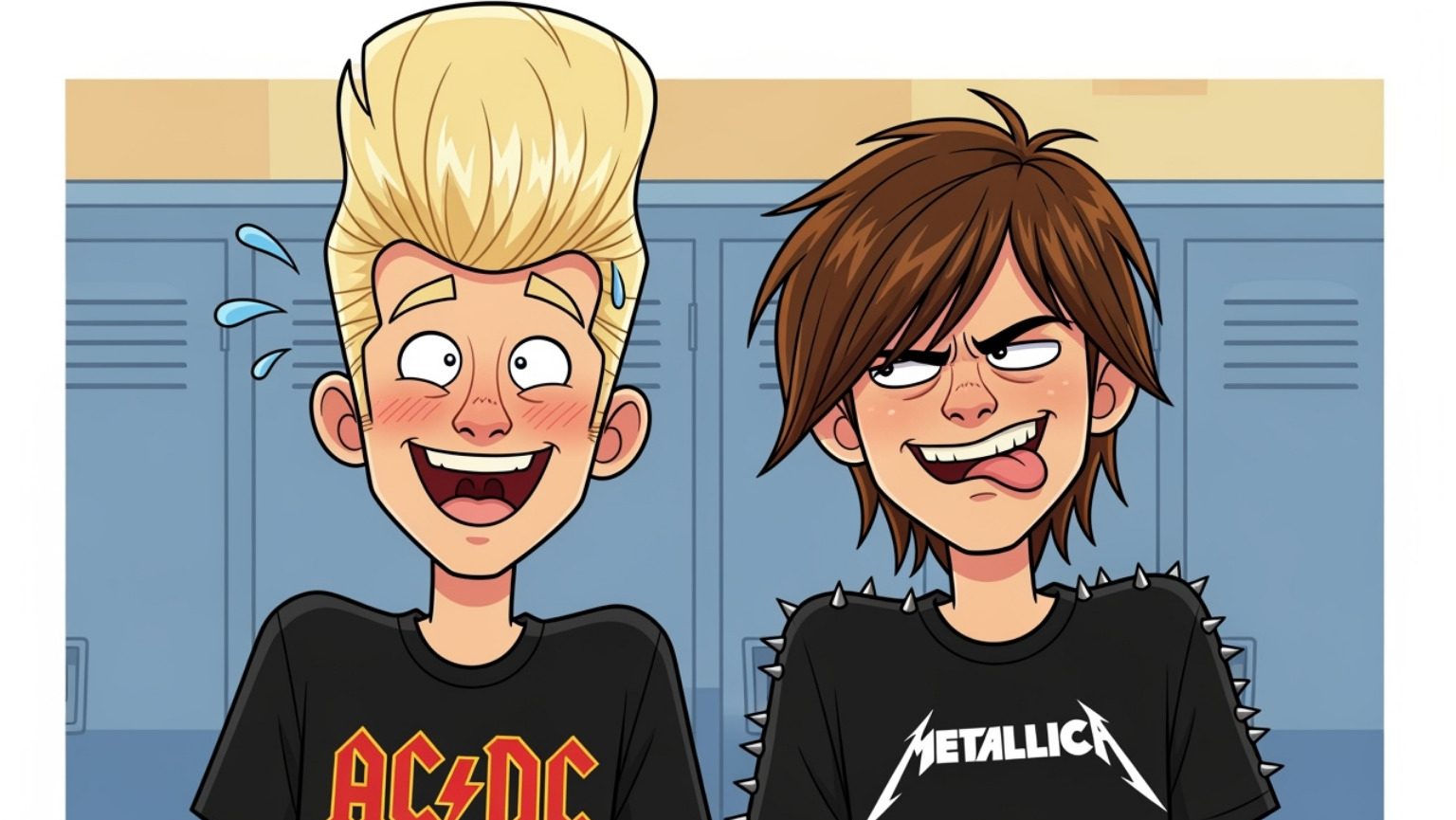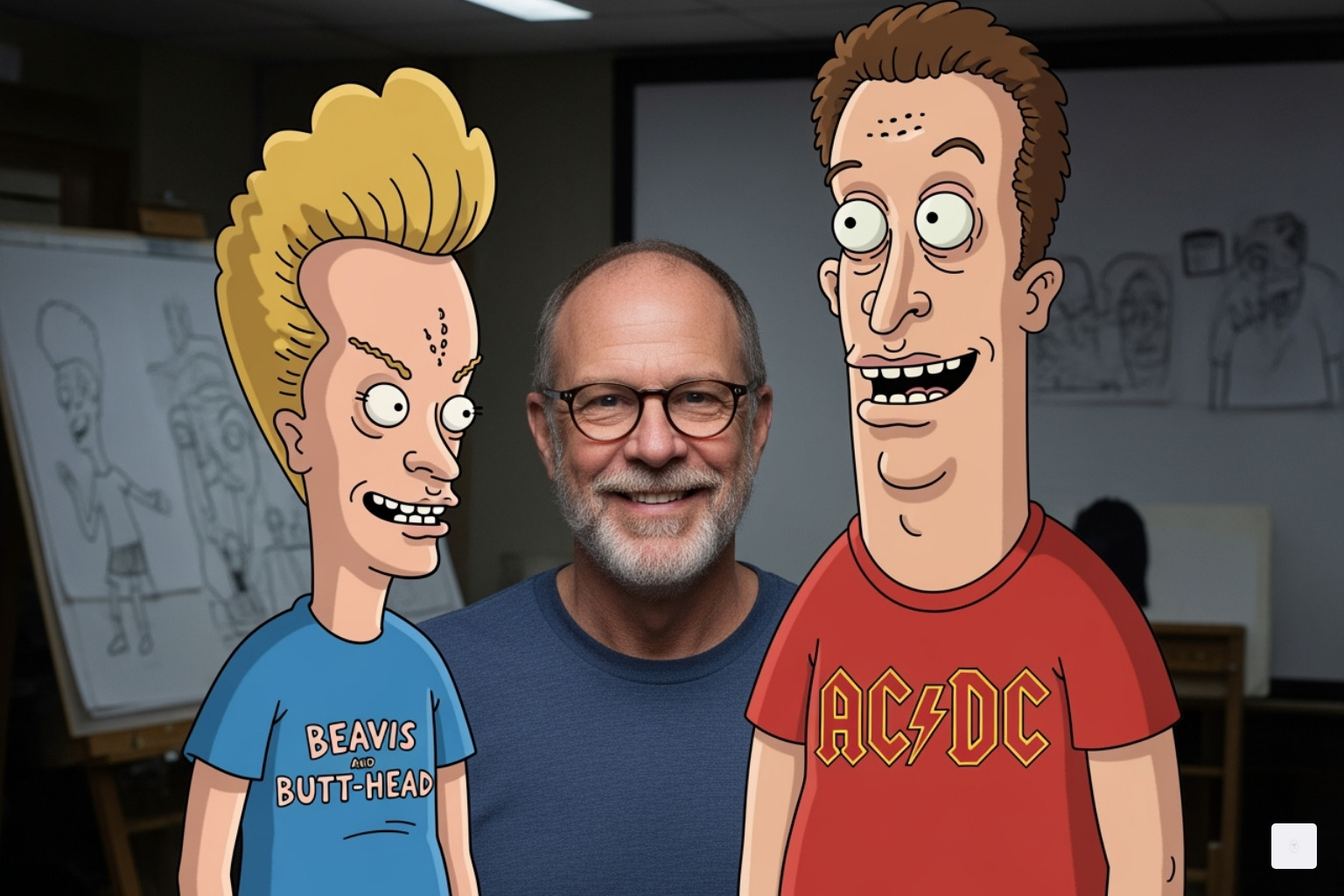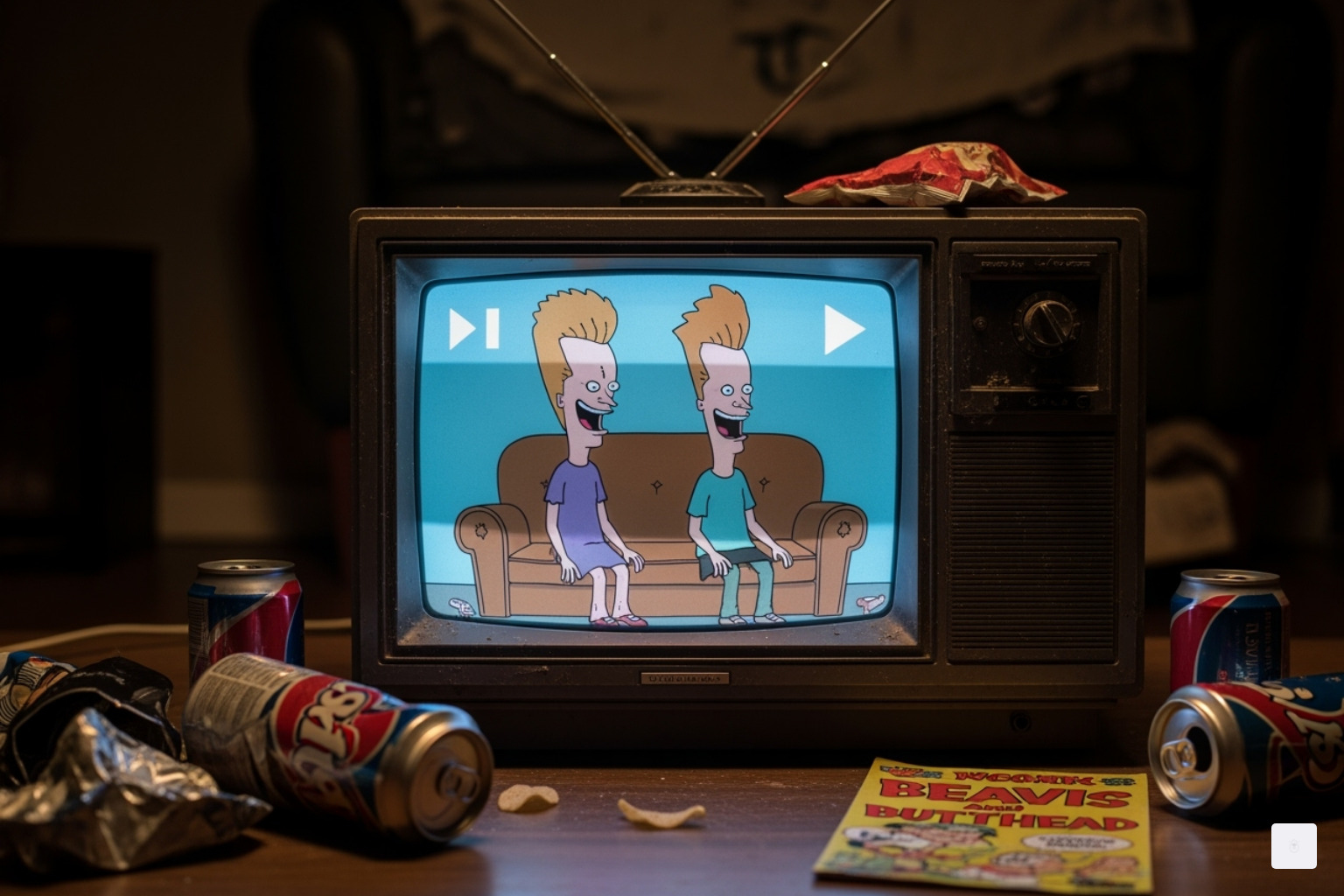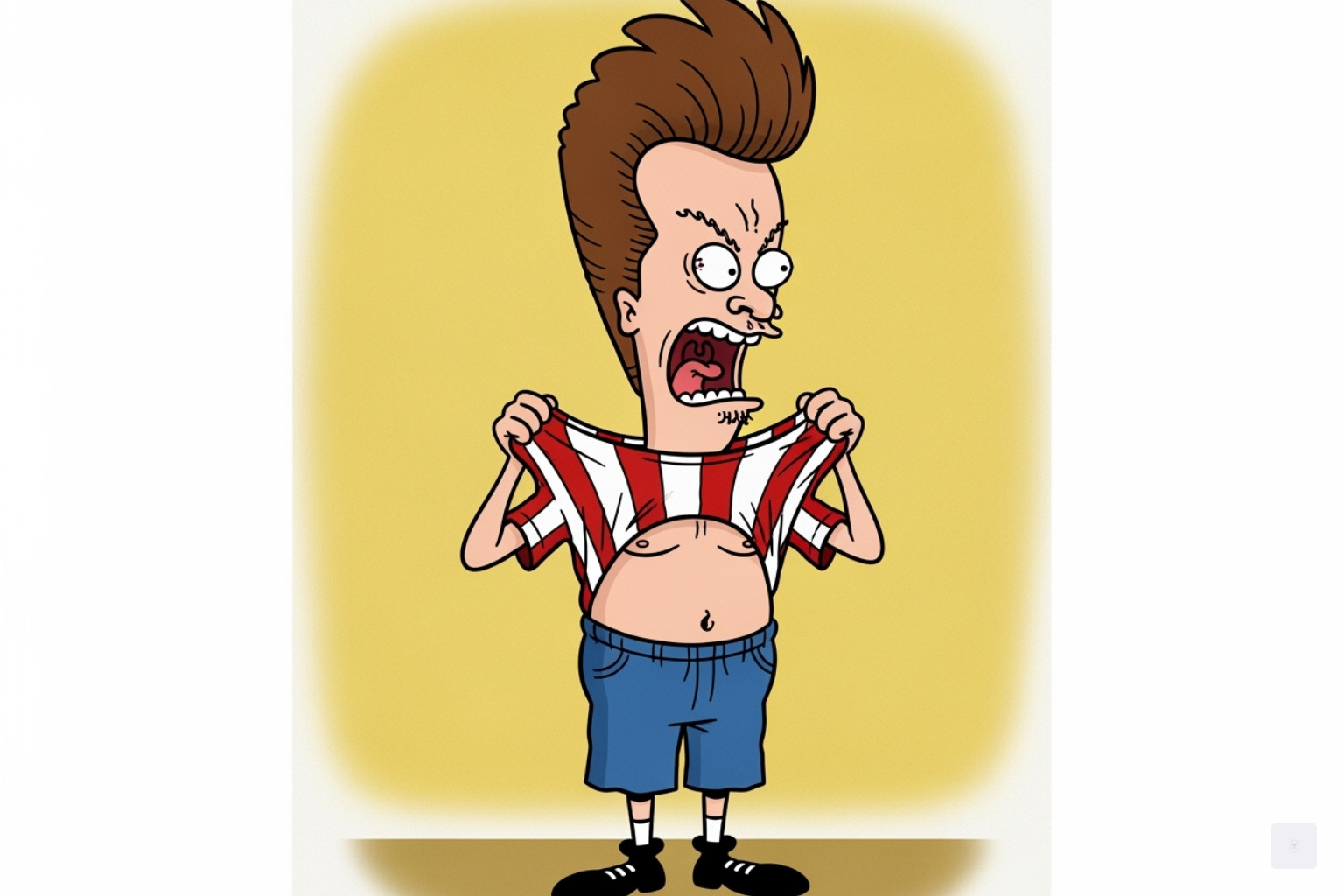
The Enduring Stupidity of a Cultural Phenomenon
Beavis and Butt-Head is an American adult animated sitcom by Mike Judge about two teenage slackers who critique pop culture and stumble through life. Originally on MTV from 1993 to 1997, it was revived in 2011 and again in 2022 on Paramount+.
Quick Facts About Beavis and Butt-Head:
- Creator: Mike Judge (who also voices both main characters)
- Original Run: March 8, 1993 – November 28, 1997 (MTV)
- Total Episodes: 270+ episodes across 10 seasons
- Current Streaming: Paramount+ (2022 revival series and remastered classics)
- Films: Two theatrical releases – “Do America” (1996) and “Do the Universe” (2022)
- Cultural Impact: Became MTV’s highest-rated show and a defining voice of Generation X
When Mike Judge created his $800 animated short “Frog Baseball” in 1992, he couldn’t have imagined the cultural phenomenon it would become. What began as crude drawings of two teenage metalheads evolved into one of television’s most influential animated series, enduring for over three decades.
The show’s impact went far beyond TV, influencing comedy and youth culture, especially in hubs like New York City, where the duo’s irreverent take on pop culture resonated with audiences. From our vantage point covering New York City’s vibrant entertainment scene at R. Couri Hay Columns, we’ve witnessed how Beavis and Butt-Head have helped shape media discourse. The show’s satirical edge continues to impact conversations throughout New York and beyond.

Key beavis and butthead vocabulary:
The Genesis of Idiocy: Creation and Premise

Mike Judge’s journey from physics major to animation legend proves that groundbreaking ideas can come from anywhere. Before they were icons, Beavis and Butt-Head were just crude drawings Judge brought to life with a basic camera and a self-taught animation style. The timing was perfect. MTV’s experimental block “Liquid Television” needed edgy content for Generation X, and Judge’s “Frog Baseball” short was an immediate hit at a 1992 animation festival. MTV executives quickly signed him, turning his $800 gamble into a seven-figure deal.
Who Created the Duo?
Creator Mike Judge had an unlikely path, moving from a physics degree and government work to animation. He taught himself the craft through trial and error, developing a raw style inspired by “Peanuts” and John Kricfalusi’s bold techniques. He wanted the characters to look like they were “drawn by an insane person.”
The names came from real life: Butt-Head was a college nickname, and Beavis was inspired by a person named Bobby Beavis, though Judge created the personality from scratch. Even Beavis’s signature snicker was borrowed from a high school classmate. Judge’s decision to voice both characters himself was a stroke of genius, giving the show its unique comedic rhythm.
How Mike Judge Got His Start in Animation (2014)
What is the Show About?
Beneath the crude humor lies a sharp satire of American youth culture. The show follows two heavy-metal fans in the fictional town of Highland whose lives revolve around watching music videos. Their commentary is both hilarious and surprisingly insightful, boiling everything down to a simple binary: it’s either “cool” or it “sucks.”
Their “mistrips” usually involve failed attempts to score with girls or causing chaos at minimum-wage jobs. Yet, their apparent stupidity often exposed the absurdities of the adult world. Critics like Roger Ebert saw them as “idiot savants” reflecting societal alienation and “television zombiehood.” In media-savvy cities like New York, audiences immediately grasped the show’s satirical edge. Judge used their ignorance to highlight the ridiculous aspects of pop culture, making their commentary a form of disguised social critique.
A Journey Through Time: The Broadcast History of Beavis and Butt-Head

The three-decade journey of Beavis and Butt-Head is a masterclass in cultural staying power. From an MTV hit to a streaming staple, the show has adapted its format to reflect the media of the times, proving great characters can transcend their original format. The show has moved from 15-minute episodes to 22-minute formats and back to 11-minute takes on modern media, even accepting multiverse concepts to keep the storytelling fresh.
| Platform | Years | Format | Commentary Focus |
|---|---|---|---|
| MTV (Original) | 1993 – 1997 | 15 min episodes | Music videos |
| MTV (Revival) | 2011 | 22 min episodes | Reality TV, Internet videos |
| Paramount+ | 2022 – Present | 11 min episodes | Modern reality TV, YouTube, UFC |
The Original MTV Run (1993 – 1997)
When Beavis and Butt-Head premiered on March 8, 1993, it became more than MTV’s highest-rated series — it became the voice of a generation. Their crude vocabulary, including terms like “ass-munch” and “fart-knocker,” became a shared language for viewers. The original run also introduced Daria Morgendorffer, whose intelligence was a perfect foil to the duo’s ignorance, eventually earning her a spin-off. The series wrapped in 1997 with a self-aware message, thanking the crew for making the characters “look so dumb.”
The 2011 MTV Revival
Fourteen years later, Beavis and Butt-Head returned to a new media landscape. The 2011 revival shifted their commentary to reality TV shows like “Jersey Shore” and viral internet videos. While the premiere drew a strong 3.3 million viewers, ratings ultimately settled around 900,000 by the season’s end. Mike Judge later attributed the cancellation to a changing network demographic, yet critics praised the revival for its sharp satire, which felt especially relevant in media-saturated centers such as New York City.
The Recent Era and Streaming Availability (2022 – Present)
The streaming era has been the duo’s most exciting chapter. A new movie, “Beavis and Butt-Head Do the Universe” (2022), led directly into the current Paramount+ series “Mike Judge’s Beavis and Butt-Head.” This latest version sees them riffing on everything from TikTok to UFC fights.
Paramount+ has also released remastered versions of all 227 original episodes, many with the music videos restored. New installments are expected to premiere on Comedy Central starting in 2025, and industry reports confirm the series has already been renewed for a third season, ensuring a bright future for our favorite idiots.
Cultural Impact, Controversy, and Critical Reception

When Beavis and Butt-Head hit the airwaves, it didn’t just entertain; it sparked a cultural revolution. The show became a mirror for Generation X, reflecting youth rebellion and the anxieties of a TV-saturated society. Its influence was so profound that it created lessons in crisis management still studied by public-relations professionals today.
More info about crisis management pr services
A Voice of a Generation
Beavis and Butt-Head captured the 90s youth spirit with their anti-establishment humor and apathy. Their worldview — where everything is “cool” or “sucks” — became an unofficial philosophy for Gen X, and their catchphrases spread like wildfire. Beavis’s alter-ego, The Great Cornholio, desperately seeking “T.P. for my bunghole,” became a true cultural icon. In cultural hubs like New York City, the show’s raw honesty resonated with young people skeptical of mainstream media, influencing an entire wave of comedians and artists.
The Firestorm of Controversy
The show’s popularity came at a price. In 1993, a tragic house fire in Ohio was blamed on a child allegedly imitating Beavis’s fascination with flames, triggering a moral panic. A prominent U.S. senator even mispronounced their names as “Buffcoat and Beaver” during congressional hearings. In response, MTV moved the show to after 11 p.m., added disclaimers, and censored all references to fire. Beavis’s iconic “Fire! Fire!” chant was removed or altered. Ironically, it was later revealed that the family involved didn’t have cable TV, but the censorship remained.
Critical Acclaim and Backlash
Despite the outcry, respected critics defended the series. Renowned film reviewer Roger Ebert praised it as brilliant satire, calling the duo “idiot savants” who expose truths about American narcissism and screen addiction. Late-night legend David Letterman was also a fan, lending his voice to the show. However, the backlash was intense, with figures such as President Clinton publicly deriding them. This debate over “pure stupidity versus genius satire” endures, and numerous best-of lists now rank the show among television’s greatest cartoons, cementing its complicated legacy.
Beyond the Couch: The Franchise’s Expansion and Where to Watch
Beavis and Butthead grew from two idiots on a couch into a massive franchise, conquering movie theaters, music charts, and video games. Their cultural footprint expanded worldwide, proving that the simplest ideas often have the most staying power. The franchise has adapted to new media, from music videos to TikTok, while staying true to its core: two metalheads judging if something “sucks” or is “cool.”
The Duo’s Foray into Film and Music
The franchise expanded successfully into film and music. The 1996 movie Beavis and Butt-Head Do America was a box office smash, earning over $60 million on a $12 million budget and setting a December opening weekend record. A 2022 sequel, Beavis and Butt-Head Do the Universe, brought the duo into the modern era on Paramount+.
Their musical ventures were also a hit. The Beavis and Butt-Head Experience album went double-platinum, featuring major artists. The most memorable track was a collaboration with Cher on “I Got You Babe,” which charted internationally and demonstrated their status as legitimate pop culture figures.
How to Watch Beavis and Butt-Head Episodes Online Today
Finding Beavis and Butthead episodes is easier than ever. Here’s where to look for the best viewing experience:
- Paramount+: This is the definitive home for all modern Beavis and Butthead content. It hosts the Mike Judge’s Beavis and Butt-Head revival, the Do the Universe film, and all 227 remastered original episodes, many with the original music videos restored.
- Comedy Central: New episodes are scheduled to air on the channel starting in 2025, expanding the franchise’s reach back to traditional cable.
- Digital Retailers: For movie nights, both films are available for purchase or rental on platforms like Amazon Prime Video, Apple TV, Google Play, and Vudu.
For viewers in New York City, accessing this content is simple through standard streaming subscriptions. Keep an eye on local pop culture events, as special screenings sometimes occur at conventions or film festivals celebrating animation history.
Frequently Asked Questions about Beavis and Butt-Head
As someone who has covered pop culture from New York’s media epicenter for decades, I often get questions about Beavis and Butthead. Here are the most common ones.
Why were some episodes of Beavis and Butt-Head censored?
The show was censored in 1993 after being controversially linked to a house fire. This sparked a moral panic, leading MTV to move the show to a late-night slot, add disclaimers, and edit out all references to fire, including Beavis’s iconic “Fire! Fire!” chant. The controversy was later found to be based on false information, as the family involved didn’t even have cable TV, but the censorship remained.
Is Daria from Beavis and Butt-Head?
Yes, absolutely. Daria Morgendorffer was created for Beavis and Butthead as an intelligent, cynical foil to the duo’s idiocy. Her deadpan wit made her an instant fan favorite, and her popularity led to her own successful spin-off series, Daria, which premiered in 1997. It’s a testament to the show’s creative depth that it could produce such a beloved and sophisticated character.
Will there be more new episodes of the show?
Yes, the duo isn’t going anywhere. The revival series Mike Judge’s Beavis and Butt-Head has been renewed for a third season on Paramount+. Additionally, new episodes are scheduled to air on Comedy Central starting in 2025. In a world filled with viral videos and social media, their commentary feels more relevant than ever, and it’s exciting to see they still have plenty of cultural stupidity to explore.
Conclusion: Why the Duo Still Rules
Over three decades later, Beavis and Butthead still prove that profound commentary can come in a stupid package. Their appeal transcends nostalgia, resting on Mike Judge’s brilliant satire of societal absurdity. They evolve with the times, critiquing 90s metal videos and modern TikTok clips with the same binary worldview: it’s either “cool” or it “sucks.”
The recent Saturday Night Live sketch featuring Ryan Gosling and Mikey Day as live-action versions of the duo went viral, proving their humor connects across generations and introducing them to a new audience.
Here in New York City, the show’s influence on comedy and social commentary is undeniable. The city’s art and music scenes have always acceptd the kind of anti-establishment humor the show pioneered. At R. Couri Hay Columns, we’ve seen how cultural phenomena like Beavis and Butthead shape the trends we cover. Their success highlights the power of an authentic voice—a principle we value in our own cultural analysis from our New York City perspective.
More info about branding services
As the duo continues with new seasons, one thing is certain: in a world that takes itself too seriously, we need voices willing to call out what “sucks” and celebrate what’s “cool.” That’s why, after all these years, Beavis and Butthead still rule.

